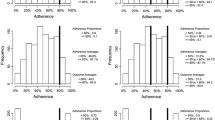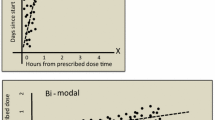Abstract
Maintaining high medication adherence is essential for achieving desired efficacy in clinical trials, especially prevention trials. However, adherence is traditionally measured by self-reports that are subject to reporting biases and measurement error. Recently, electronic medication dispenser devices have been adopted in several HIV pre-exposure prophylaxis prevention studies. These devices are capable of collecting objective, frequent, and timely drug adherence data. The device opening signals generated by such devices are often represented as regularly or irregularly spaced discrete functional data, which are challenging for statistical analysis. In this paper, we focus on clustering the adherence monitoring data from such devices. We first pre-process the raw discrete functional data into smoothed functional data. Parametric mixture models with change-points, as well as several non-parametric and semi-parametric functional clustering approaches, are adapted and applied to the smoothed adherence data. Simulation studies were conducted to evaluate finite sample performances, on the choices of tuning parameters in the pre-processing step as well as the relative performance of different clustering algorithms. We applied these methods to the HIV Prevention Trials Network 069 study for identifying subgroups with distinct adherence behavior over the study period.



Similar content being viewed by others
References
Akaike H (1974) A new look at the statistical model identification. IEEE Trans Autom Control 19(6):716–723
Bélisle CJ (1992) Convergence theorems for a class of simulated annealing algorithms on \({\mathbb{R}}^d\). J Appl Probab 29(4):885–895
Chiou JM, Li PL (2007) Functional clustering and identifying substructures of longitudinal data. J R Stat Soc 69(4):679–699
Fraley C, Raftery AE (2002) Model-based clustering, discriminant analysis, and density estimation. J Am Stat Assoc 97(458):611–631
Gable AR, Lagakos SW (2008) Methodological challenges in biomedical HIV prevention trials. National Academies Press, Washington, DC
Gibaldi M, Nagashima R, Levy G (1969) Relationship between drug concentration in plasma or serum and amount of drug in the body. J Pharm Sci 58(2):193–197
Grant RM, Anderson PL, McMahan V, Liu A, Amico KR, Mehrotra M, Hosek S, Mosquera C, Casapia M, Montoya O (2014) Uptake of pre-exposure propylaxis, sexual practices, and hiv incidence in men and transgender women who have sex with men: a cohort study. Lancet Infect Dis 14(9):820–829
Gulick RM, Wilkin TJ, Chen YQ, Landovitz RJ, Amico KR, Young AM, Richardson P, Marzinke MA, Hendrix CW, Eshleman SH (2016) Phase 2 study of the safety and tolerability of maraviroc-containing regimens to prevent hiv infection in men who have sex with men (hptn 069/actg a5305). J Infect Dis 215(2):238–246
Haberer JE, Kahane J, Kigozi I, Emenyonu N, Hunt P, Martin J, Bangsberg DR (2010) Real-time adherence monitoring for HIV antiretroviral therapy. AIDS Behav 14(6):1340–1346 PMCID: PMC2974938
Hall P, Müller HG, Yao F (2008) Modelling sparse generalized longitudinal observations with latent gaussian processes. J R Stat Soc 70(4):703–723
Hartigan JA, Wong MA (1979) Algorithm as 136: a k-means clustering algorithm. J R Stat Soc Ser C 28(1):100–108
Huang H, Li Y, Guan Y (2014) Joint modeling and clustering paired generalized longitudinal trajectories with application to cocaine abuse treatment data. J Am Stat Assoc 109(508):1412–1424
Hubert L, Arabie P (1985) Comparing partitions. J Classif 2(1):193–218
Jacques J, Preda C (2014) Functional data clustering: a survey. Adv Data Anal Classif 8(3):231–255
James GM, Sugar CA (2003) Clustering for sparsely sampled functional data. J Am Stat Assoc 98(462):397–408
Kass RE, Raftery AE (1995) Bayes factors. J Am Stat Assoc 90(430):773–795
Lewis AS, Overton ML (2013) Nonsmooth optimization via quasi-newton methods. Math Progr 141(1–2):135–163
Louis TA (1982) Finding the observed information matrix when using the EM algorithm. J R Stat Soc Ser B 44:226–233
Peng J, Müller HG (2008) Distance-based clustering of sparsely observed stochastic processes, with applications to online auctions. Ann Appl Stat 2(3):1056–1077
Rand WM (1971) Objective criteria for the evaluation of clustering methods. J Amn Stat Assoc 66(336):846–850
Schwarz G (1978) Estimating the dimension of a model. Ann Stat 6(2):461–464
Tibshirani R, Walther G (2005) Cluster validation by prediction strength. J Comput Graph Stat 14(3):511–528
Vermunt JK (2010) Latent class modeling with covariates: two improved three-step approaches. Polit Anal 18(4):450–469
Vrijens B, Vincze G, Kristanto P, Urquhart J, Burnier M (2008) Adherence to prescribed antihypertensive drug treatments: longitudinal study of electronically compiled dosing histories. BMJ 336(7653):1114–1117
Ward JH Jr (1963) Hierarchical grouping to optimize an objective function. J Am Stat Assoc 58(301):236–244
Yao F, Müller HG, Wang JL (2005) Functional linear regression analysis for longitudinal data. Ann Stat 33(6):2873–2903
Acknowledgements
This was partially supported by two grants from the National Institutes of Health (NIH), R01AI121259 and R01HL130483.
Author information
Authors and Affiliations
Corresponding author
Electronic supplementary material
Below is the link to the electronic supplementary material.
Rights and permissions
About this article
Cite this article
Zhu, Y., Di, C. & Chen, Y.Q. Clustering Functional Data with Application to Electronic Medication Adherence Monitoring in HIV Prevention Trials. Stat Biosci 11, 238–261 (2019). https://doi.org/10.1007/s12561-019-09232-8
Received:
Revised:
Accepted:
Published:
Issue Date:
DOI: https://doi.org/10.1007/s12561-019-09232-8




